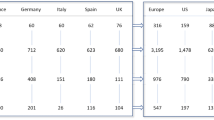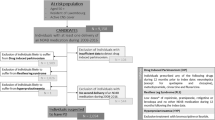Summary
OBJECTIVE: The objective of this study was to analyse the costs and the situation of care in patients with idiopathic Parkinson's disease (PD) in Austria. Continuously increasing healthcare costs and the fact that the prevalence of PD is expected to double in the next 25 years highlight the importance of health-economic evaluation in PD. METHOD: Patient survey with 81 patients with idiopathic Parkinson's disease. A bottom-up approach has been used to calculate direct and indirect costs from a societal perspective. Cost-driving factors were identified by multiple regression analysis. RESULTS: The overall costs from the perspective of society was 9280 € per patient within a six-month period and consisted of 60% direct costs (5910 €) and 40% indirect costs (3910 €). The major part (59%) of direct costs was paid by the national healthcare. Co-payments of patients were 810 € per six-months. The annual nationwide costs of PD in Austria are estimated to be approximately 320 million €. CONCLUSION: PD is an economic challenge for the Austrian healthcare system. Direct costs account for the most part and are on account of the national healthcare system. In addition, patients bear considerable costs by personal contribution.
Zusammenfassung
ZIELSETZUNG: Ziel dieser Studie war die Ermittlung der Krankheitskosten und der Versorgungssituation bei Patienten mit Parkinson-Erkrankung in Österreich. Steigende Ausgaben im Gesundheitswesen und die Prognose der Verdopplung der Zahl der Krankheitsfälle in den nächsten 25 Jahren machen ökonomische Evaluationen unerlässlich. METHODEN: Patientenbefragung von 81 Patienten mit idiopathischem Morbus Parkinson. Zur Ermittlung von direkten und indirekten Krankheitskosten wurde ein bottom up-Ansatz angewandt. Die kostentreibenden Faktoren wurden mittels multiplen Regressionsanalysen identifiziert. ERGEBNISSE: Die Gesamtkosten aus der gesellschaftlichen Perspektive belaufen sich auf 9820 € pro Patient innerhalb eines 6-Monatszeitraums. Sie bestehen zu 60% aus direkten Kosten (5910 €) und zu 40% aus indirekten Kosten (3910 €). Der größte Anteil (59%) der direkten Kosten sind Ausgaben, die die gesetzliche Krankenversicherung zu leisten hat. Der Patient hat durchschnittlich einen Selbstbehalt von ca. 810 € im 6-Monatszeitraum zu entrichten. Die jährlichen Krankheitskosten in Österreich werden auf ca. 320 Millionen Euro geschätzt. SCHLUSSFOLGERUNG: Morbus Parkinson stellt eine ökonomische Herausforderung für das nationale Gesundheitswesen dar. Direkte Krankheitskosten fallen zum größten Teil zu Lasten der gesetzlichen Krankenversicherung. Bei den Patienten fallen hohe Kosten durch finanzielle Selbstbeteiligung an.
Similar content being viewed by others
Literatur
Andlin-Sobocki P, Jonsson B, Wittchen HU, Olesen J (2005) Costs of disorders of the brain in Europe. Eur J Neurol 12 [Suppl 1]: 1–27
Parkinson's disease. World Health Organization. Online at www.who.int/inf-pr-1998/en/pr98-71.html Accessed 15 January 2009
Lindgren P, von Campenhausen S, Spottke AE, Siebert U, Dodel R (2005) Cost of Parkinson's disease in Europe. Eur J Neurol 12 [Suppl 1]: 68–73
Hoehn MM, Yahr M (1967) Parkinsonism: onset, progression and mortality. Neurology 5: 427–442
LePen C, Wait S, Moutard-Martin F, Dujardin M, Ziegler M (1999) Cost of illness and disease severity in a cohort of French patients with Parkinson's disease. Pharmacoeconomics 16: 59–69
Hagell P, Nordling S, Reimer J, Grabowski M, Persson U (2002) Resource use and costs in a Swedish cohort of patients with Parkinson's disease. Mov Disord 17: 1213–1220
Findley L, Aujla M, Bain PG, Baker M, Beech C, Bowman C, et al (2003) Direct economic impact of Parkinson's disease: a research survey in the United Kingdom. Mov Disord 18: 1139–1145
Keranen T, Kaakkola S, Sotaniemi K (2003) Economic burden and quality of life impairment increase with severity of PD. Parkinsonism Relat Disord 9: 163–168
Spottke AE, Reuter M, Machat O, Bornschein B, von Campenhausen S, Berger K, et al (2005) Cost of illness and its predictors for Parkinson's disease in Germany. Pharmacoeconomics 23: 817–836
Gibb WR, Lees AJ (1989) The significance of the Lewy body in the diagnosis of idiopathic Parkinson's disease. Neuropathol Appl Neurobiol 15: 27–44
Winter Y, Wolfram C, Schöffski O, Dodel RC, Back T (2008) Langzeitkrankheitskosten 4 Jahre nach Schlaganfall oder TIA in Deutschland. Nervenarzt 79: 918–926
Hamer HM, Spottke A, Aletsee C, Knake S, Reis J, Strzelczyk A, et al (2006) Direct and indirect costs of refractory epilepsy in a tertiary epilepsy center in Germany. Epilepsia 47: 2165–2172
Fahn S, Elton RL, Members of the UPDRS Development Committee (1987) Unified Parkinson's disease rating scale. In: Fahn S, Marsden CD, Calne DB, Goldstein M (eds) Recent developments in Parkinson's disease II. Macmillan, New York, p 153–163
Statistik Austria. Statistisches Jahrbuch 2009. www.statistik.at/web_de/services/stat_jahrbuch/index.html Accessed 08 January 2009
Bundesministerium für Gesundheit und Frauen (2005) Leistungsorientierte Krankenanstaltfinanzierung. Leistungskatlog 2005. BMGF, Wien
Barber JA, Thompson SG (2000) Analysis of cost data in randomized trials: an application of the non-parametric bootstrap. Statistics In Medicine 19: 3219–3236
Efron B, Tibshirani RJ (1993) An Introduction to the Bootstrap. Chapman and Hall, London
Dengler I, Leukel N, Meuser T, Jost WH (2006) Prespektive Erfassung der direkten und indirekten Kosten des idiopathischen Parkinson-Syndroms. Nervenarzt 77: 1204–1209
Whetten-Goldstein K, Sloan F, Kulas E, et al (1997) The burden of Parkinson's disease on society, family, and the individual. J Am Geriatr Soc 45 (7): 844–849
Huse DM, Schulman K, Orsini L, Castelli-Haley J, Kennedy S, Lenhart G (2005) Burden of illness in Parkinson's disease. Mov Disord 20 (11): 1449–1454
Dorsey ER, Constantinescu R, Thompson JP, Biglan KM, Holloway RG, Kieburtz K, et al (2007) Projected number of people with Parkinson disease in the most populous nations, 2005 through 2030. Neurology 68 (5): 384–386
Author information
Authors and Affiliations
Corresponding author
Rights and permissions
About this article
Cite this article
von Campenhausen, S., Winter, Y., Gasser, J. et al. Krankheitskosten und Versorgungssituation bei Morbus Parkinson – eine Analyse in Österreich. Wien Klin Wochenschr 121, 574–582 (2009). https://doi.org/10.1007/s00508-009-1223-6
Received:
Accepted:
Issue Date:
DOI: https://doi.org/10.1007/s00508-009-1223-6




